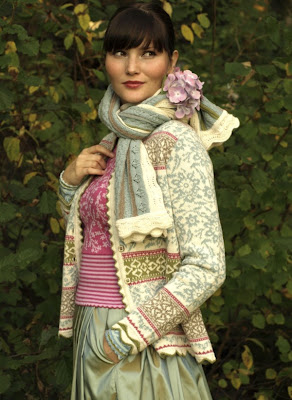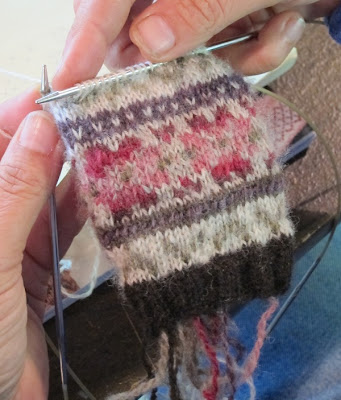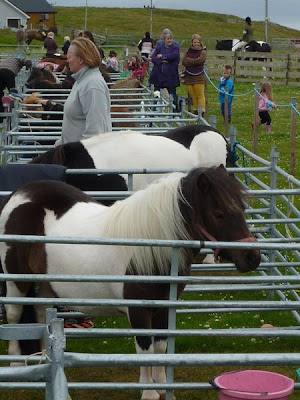Inspiration...
 |
| My flock sweater |
After watching Martha and Elizabeth knit their allovers in October, I decided it was about time to get back to work on my 'flock sweater'. I'd set it aside a few years ago after I finished the sleeves. I'd run out of black and needed to spin some more, all the bobbins on my wheel were full...you know the drill...So it went into what my husband fondly refers to as the 'Great Hall of Unfinished Projects' - we all have one. Mine really isn't all that large, it's just that DH finds the whole concept rather odd, but then he doesn't knit (or spin or weave or...).
 |
| 'Buttercup' |
All of the colors in my sweater have a corresponding face that goes with them. Most of the browns in the sweater come from different shearings from different years from Buttercup, a now 8 year old Shetland ewe.
 |
| Ylletroja Shetlands |
An advantage to raising Shetland sheep is the wide range in the fleece colors 'on the hoof'. That diversity made the planning of the colorway for my sweater a lot of fun.
As for the design, I headed for one of my favorite knitting books,
Poetry in Stitches, by Solveig Hisdal (published in 2000). Solveig is the designer for the Norwegian knitwear company,
Oleana. She has won numerous awards for her knitwear designs. On a warm summer night in Oslo before the theater starts you can see numerous woman dressed in Oleana sweaters and matching silk skirts stroll by - her designs have become the contemporary version of the bunad or folk costume in Norway.
 |
| Solveig Hisdal sweater design from Poetry in Stitches |
The pattern I used for my sweater in her book was knit in red, blue, green, gold and black. I have been able to adapt it really well to the natural Shetland colors. But the thing that really excites me (again and again) about her pattern design and color choice is the fact that they are often inspired by old textiles.
 |
| Woolen bunad bodice form Hallingdal from Poetry in Stitches |
Museums contain a wealth of old textiles that are often ignored. Solveig Hisdal has used these old textiles and artifacts as inspiration for her designs. She's able to see in a way that most of us do not and create a thoroughly modern textile that honors the spirit of these old pieces. Her book not only includes her own sweater designs, but also photos of the old pieces that have inspired her. Many are textiles, but she has also included photos of architectural details of old buildings, old paintings of bunad, flowers and the landscape.
 |
| My Christmas sweater |
Many years ago, I found this sweater in a little shop in Stillwater, Minnesota. I fell in love with it immediately. At that time I had never heard of Oleana or Solveig Hisdal. (To this day, you still have to work really hard to find her work in the US - not so in Norway!) The price was dear, but I have never regretted buying it. Each year I pull it out of the closet in December and remember again why I love her work so much.
 |
| A few pieces in the 2012 Oleana knitwear collection |
Each year
Oleana continues to put out new designs. They continue to offer new pieces in their lines that now include home furnishings as well as women's wear. As time changes, so do the materials that they are using. My Christmas sweater was all wool. Today, you will find more wool/silk blends and alpaca fibers, much as you would in other contemporary women's wear, but the essence of her designs remain the same.
I'm happy to be back knitting my 'Flock sweater'...inspiration comes in many forms....Thank you Martha and Elizabeth!
 |
| Martha's newly finished allover |
For more information about Oleana, click on this video link to watch their 2006 video about the company. Although the video is in Norwegian, it will give you a chance to meet the owners of Oleana - Signe Aarhus and Kolbjorn Valestrand - as well as the companies designer, Solveig Hisdal. It includes a factory tour of Oleana (they've chosen to make their sweaters entirely in Norway), their employees annual trip abroad as well as a fashion show that they held at the Nordsik Museum, in Stockholm, Sweden.











































